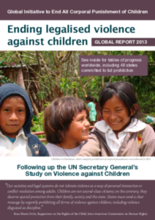This comprehensive report by the Global Initiative to End All Corporal Punishment of Children analyses data regarding progress toward eliminating corporal punishment amongst all states party to the UN Convention on the Rights of the Child (UNCRC). It reports that 34 states have prohibited corporal punishment in all settings and children are legally protected from corporal punishment in alternative care settings (foster care, institutions, etc.) in 41 states. (Note: As of February 2014, 35 states have full prohibition and 42 states have prohibition in alternative care setting). As of November 2013, an additional 49 states had indicated their commitment to full prohibition as well. The report highlights that currently, only 5.4% of the global child population is protected in law from all corporal punishment, but should all the states indicating commitment to prohibition were to do so, this figure would increase to 45.9% of children around the world. According to the report, this leaves a staggering 91.3% of children in alternative care not protected under the law against the use of corporal punishment.
The report highlights efforts by intergovernmental organizations such as the Council of Europe's "Raise your hand against smacking" campaign, and the South Asian Initiative to End Violence against Children, as well as efforts by international organizations such as UNICEF, Plan International, Save the Children and the Child Rights International Network. It also provides selected regional and national coalitions and NGO initiatives to provide a multi-tiered view of how the issue is being addressed. The report also gives a comprehensive description of faith-based initiatives where it highlights partnerships between church groups and various organizations working together to prohibit the use of corporal punishment. The report includes a literature review, statistics and case studies, and identifies legislative opportunities in all regions. It concludes with a state by state analysis of the legality of corporal punishment linked to a large database showing where it is prohibited or permitted while further breaking down each country's legal areas where corporal punishment is permitted (i.e., home, alternative care, school, day care, etc)

